旗袍与中国传统服饰-中英互译
- 格式:doc
- 大小:33.00 KB
- 文档页数:4
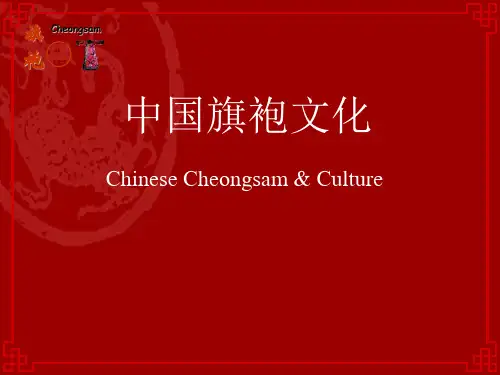

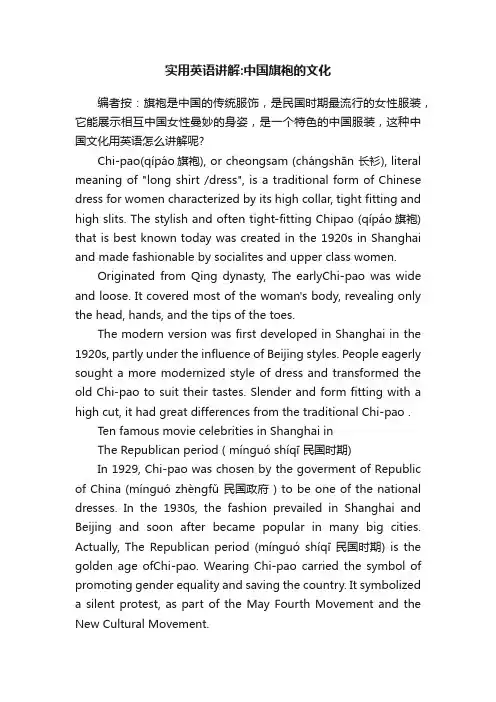
实用英语讲解:中国旗袍的文化编者按:旗袍是中国的传统服饰,是民国时期最流行的女性服装,它能展示相互中国女性曼妙的身姿,是一个特色的中国服装,这种中国文化用英语怎么讲解呢?Chi-pao(qípáo旗袍), or cheongsam (chángshān 长衫), literal meaning of "long shirt /dress", is a traditional form of Chinese dress for women characterized by its high collar, tight fitting and high slits. The stylish and often tight-fitting Chipao (qípáo旗袍) that is best known today was created in the 1920s in Shanghai and made fashionable by socialites and upper class women.Originated from Qing dynasty, The earlyChi-pao was wide and loose. It covered most of the woman's body, revealing only the head, hands, and the tips of the toes.The modern version was first developed in Shanghai in the 1920s, partly under the influence of Beijing styles. People eagerly sought a more modernized style of dress and transformed the old Chi-pao to suit their tastes. Slender and form fitting with a high cut, it had great differences from the traditional Chi-pao .Ten famous movie celebrities in Shanghai inThe Republican period ( mínguó shíqī 民国时期)In 1929, Chi-pao was chosen by the goverment of Republic of China (mínguó zhèngfǔ 民国政府 ) to be one of the national dresses. In the 1930s, the fashion prevailed in Shanghai and Beijing and soon after became popular in many big cities. Actually, The Republican period (mínguó shíqī 民国时期) is the golden age ofChi-pao. Wearing Chi-pao carried the symbol of promoting gender equality and saving the country. It symbolized a silent protest, as part of the May Fourth Movement and the New Cultural Movement.Two women wearing Chi-pao in a 1930s Shanghai advertisementFrom the 1950s to the 1970s, due to the influence of "movements" in China, especially the Chinese Cultural Revolution (1966-1976), the Chi-pao was seen as a feudal dress of the ancient times. It was abandoned as daily clothing, and people who wore Chi-pao were considered a political misbehavior at that time.Since 1980s, with the trend of renaissance of Chinese traditional culture, people in mainland China started to pay attention to the Chi-pao again. The Chi-pao is gaining popularity in films, beauty pageants, and fashion shows in both China and other countries all over the world.公众号:HanFan汉风。
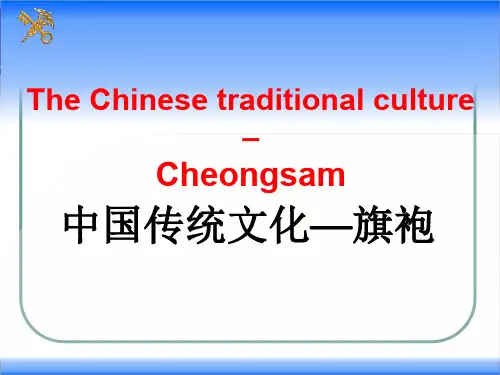
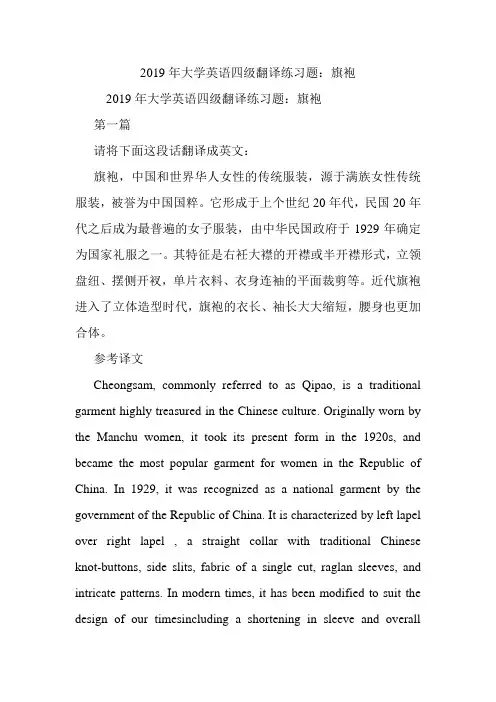
2019年大学英语四级翻译练习题:旗袍2019年大学英语四级翻译练习题:旗袍第一篇请将下面这段话翻译成英文:旗袍,中国和世界华人女性的传统服装,源于满族女性传统服装,被誉为中国国粹。
它形成于上个世纪20年代,民国20年代之后成为最普遍的女子服装,由中华民国政府于1929年确定为国家礼服之一。
其特征是右衽大襟的开襟或半开襟形式,立领盘纽、摆侧开衩,单片衣料、衣身连袖的平面裁剪等。
近代旗袍进入了立体造型时代,旗袍的衣长、袖长大大缩短,腰身也更加合体。
参考译文Cheongsam, commonly referred to as Qipao, is a traditional garment highly treasured in the Chinese culture. Originally worn by the Manchu women, it took its present form in the 1920s, and became the most popular garment for women in the Republic of China. In 1929, it was recognized as a national garment by the government of the Republic of China. It is characterized by left lapel over right lapel , a straight collar with traditional Chinese knot-buttons, side slits, fabric of a single cut, raglan sleeves, and intricate patterns. In modern times, it has been modified to suit the design of our timesincluding a shortening in sleeve and overalllength as well as more-fitted tailoring.第二篇请将下面这段话翻译成英文:旗袍(cheongsam)是独具中国特色的女性服饰,在高端时尚的国际世界中日益流行。
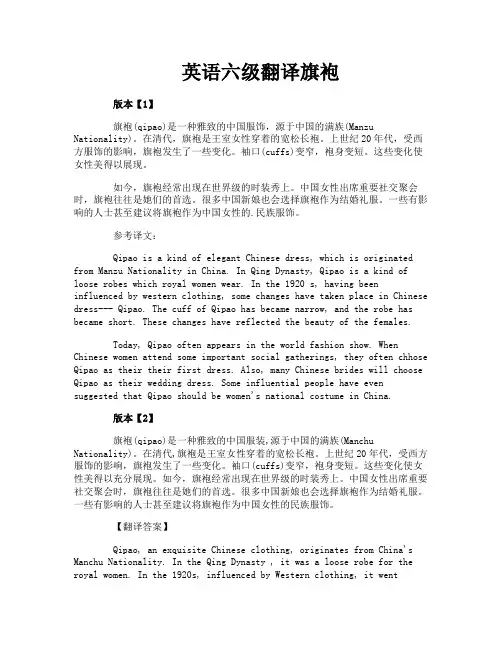
英语六级翻译旗袍版本【1】旗袍(qipao)是一种雅致的中国服饰,源于中国的满族(Manzu Nationality)。
在清代,旗袍是王室女性穿着的宽松长袍。
上世纪20年代,受西方服饰的影响,旗袍发生了一些变化。
袖口(cuffs)变窄,袍身变短。
这些变化使女性美得以展现。
如今,旗袍经常出现在世界级的时装秀上。
中国女性出席重要社交聚会时,旗袍往往是她们的首选。
很多中国新娘也会选择旗袍作为结婚礼服。
一些有影响的人士甚至建议将旗袍作为中国女性的.民族服饰。
参考译文:Qipao is a kind of elegant Chinese dress, which is originated from Manzu Nationality in China. In Qing Dynasty, Qipao is a kind of loose robes which royal women wear. In the 1920 s, having been influenced by western clothing, some changes have taken place in Chinese dress--- Qipao. The cuff of Qipao has became narrow, and the robe has became short. These changes have reflected the beauty of the females.Today, Qipao often appears in the world fashion show. When Chinese women attend some important social gatherings, they often chhose Qipao as their their first dress. Also, many Chinese brides will choose Qipao as their wedding dress. Some influential people have even suggested that Qipao should be women's national costume in China.版本【2】旗袍(qipao)是一种雅致的中国服装,源于中国的满族(Manchu Nationality)。
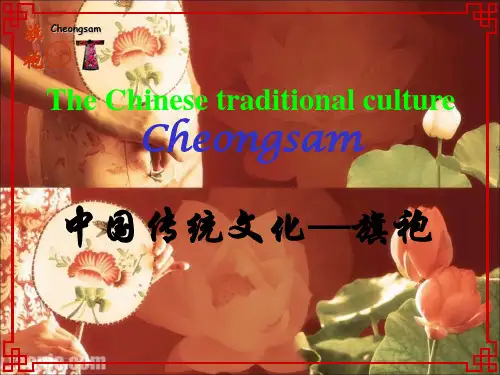
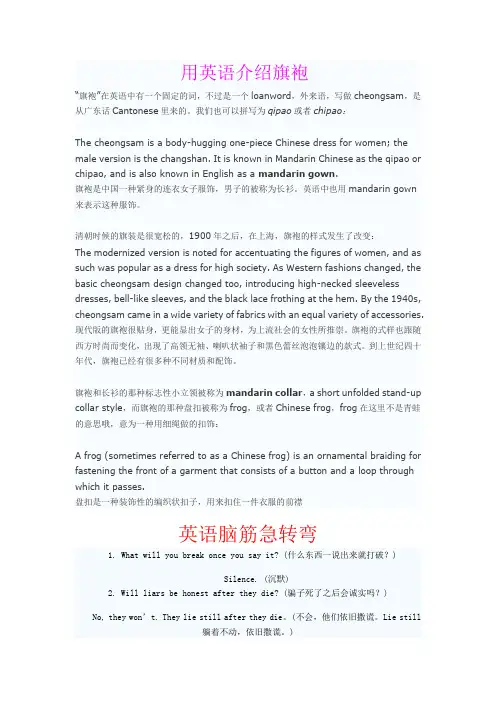
用英语介绍旗袍“旗袍”在英语中有一个固定的词,不过是一个loanword,外来语,写做cheongsam,是从广东话Cantonese里来的。
我们也可以拼写为qipao或者chipao:The cheongsam is a body-hugging one-piece Chinese dress for women; the male version is the changshan. It is known in Mandarin Chinese as the qipao or chipao, and is also known in English as a mandarin gown.旗袍是中国一种紧身的连衣女子服饰,男子的被称为长衫。
英语中也用mandarin gown来表示这种服饰。
清朝时候的旗装是很宽松的,1900年之后,在上海,旗袍的样式发生了改变:The modernized version is noted for accentuating the figures of women, and as such was popular as a dress for high society. As Western fashions changed, the basic cheongsam design changed too, introducing high-necked sleeveless dresses, bell-like sleeves, and the black lace frothing at the hem. By the 1940s, cheongsam came in a wide variety of fabrics with an equal variety of accessories. 现代版的旗袍很贴身,更能显出女子的身材,为上流社会的女性所推崇。
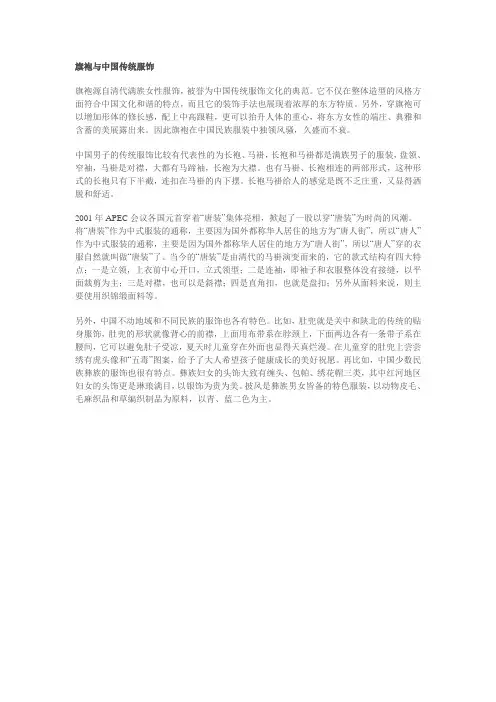
旗袍与中国传统服饰旗袍源自清代满族女性服饰,被誉为中国传统服饰文化的典范。
它不仅在整体造型的风格方面符合中国文化和谐的特点,而且它的装饰手法也展现着浓厚的东方特质。
另外,穿旗袍可以增加形体的修长感,配上中高跟鞋,更可以抬升人体的重心,将东方女性的端庄、典雅和含蓄的美展露出来。
因此旗袍在中国民族服装中独领风骚,久盛而不衰。
中国男子的传统服饰比较有代表性的为长袍、马褂,长袍和马褂都是满族男子的服装,盘领、窄袖,马褂是对襟,大都有马蹄袖,长袍为大襟。
也有马褂、长袍相连的两部形式,这种形式的长袍只有下半截,连扣在马褂的内下摆。
长袍马褂给人的感觉是既不乏庄重,又显得洒脱和舒适。
2001年APEC会议各国元首穿着“唐装”集体亮相,掀起了一股以穿“唐装”为时尚的风潮。
将“唐装”作为中式服装的通称,主要因为国外都称华人居住的地方为“唐人街”,所以“唐人”作为中式服装的通称,主要是因为国外都称华人居住的地方为“唐人街”,所以“唐人”穿的衣服自然就叫做“唐装”了。
当今的“唐装”是由清代的马褂演变而来的,它的款式结构有四大特点:一是立领,上衣前中心开口,立式领型;二是连袖,即袖子和衣服整体没有接缝,以平面裁剪为主;三是对襟,也可以是斜襟;四是直角扣,也就是盘扣;另外从面料来说,则主要使用织锦缎面料等。
另外,中国不动地域和不同民族的服饰也各有特色。
比如,肚兜就是关中和陕北的传统的贴身服饰,肚兜的形状就像背心的前襟,上面用布带系在脖颈上,下面两边各有一条带子系在腰间,它可以避免肚子受凉,夏天时儿童穿在外面也显得天真烂漫。
在儿童穿的肚兜上尝尝绣有虎头像和“五毒”图案,给予了大人希望孩子健康成长的美好祝愿。
再比如,中国少数民族彝族的服饰也很有特点。
彝族妇女的头饰大致有缠头、包帕、绣花帽三类,其中红河地区妇女的头饰更是琳琅满目,以银饰为贵为美。
披风是彝族男女皆备的特色服装,以动物皮毛、毛麻织品和草编织制品为原料,以青、蓝二色为主。
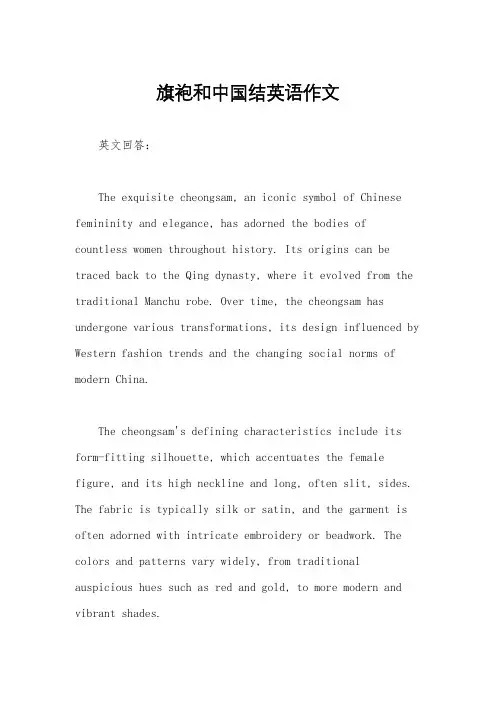
旗袍和中国结英语作文英文回答:The exquisite cheongsam, an iconic symbol of Chinese femininity and elegance, has adorned the bodies of countless women throughout history. Its origins can be traced back to the Qing dynasty, where it evolved from the traditional Manchu robe. Over time, the cheongsam has undergone various transformations, its design influenced by Western fashion trends and the changing social norms of modern China.The cheongsam's defining characteristics include its form-fitting silhouette, which accentuates the female figure, and its high neckline and long, often slit, sides. The fabric is typically silk or satin, and the garment is often adorned with intricate embroidery or beadwork. The colors and patterns vary widely, from traditional auspicious hues such as red and gold, to more modern and vibrant shades.The cheongsam has played a significant role in Chinese culture, transcending its status as mere clothing and becoming a symbol of female empowerment and liberation. In the early 20th century, it was adopted by progressive women as a way to break free from traditional gender roles. Today, the cheongsam continues to be a popular choice for formal occasions and special events, and it is frequently seen on the red carpets of international film festivals and award ceremonies.The Chinese knot, on the other hand, is a decorativeart form that has been practiced in China for centuries. These intricate knots are often used to adorn garments, jewelry, and other objects, and they are often imbued with symbolic meanings. For example, the "longevity knot" is believed to bring long life and prosperity, while the "double happiness knot" is commonly used in wedding decorations.The art of Chinese knotting involves using a single piece of cord to create elaborate symmetrical patterns. Theknots are typically tied in a series of repetitive steps, and the final product can be either flat or three-dimensional. Chinese knots are often made with auspicious colors such as red, yellow, and gold, and they arefrequently used as decorative accents in traditional Chinese architecture and design.中文回答:旗袍,中国女性柔美典雅的象征,穿梭于历史的长河中,点缀着无数女性的身姿。
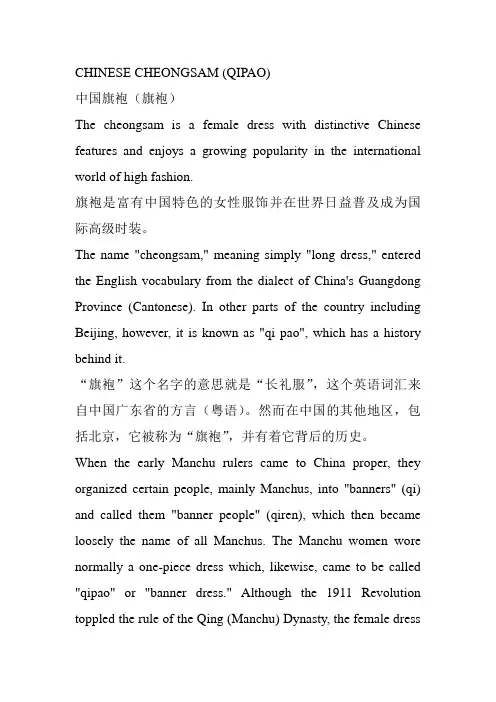
CHINESE CHEONGSAM (QIPAO)中国旗袍(旗袍)The cheongsam is a female dress with distinctive Chinese features and enjoys a growing popularity in the international world of high fashion.旗袍是富有中国特色的女性服饰并在世界日益普及成为国际高级时装。
The name "cheongsam," meaning simply "long dress," entered the English vocabulary from the dialect of China's Guangdong Province (Cantonese). In other parts of the country including Beijing, however, it is known as "qi pao", which has a history behind it.“旗袍”这个名字的意思就是“长礼服”,这个英语词汇来自中国广东省的方言(粤语)。
然而在中国的其他地区,包括北京,它被称为“旗袍”,并有着它背后的历史。
When the early Manchu rulers came to China proper, they organized certain people, mainly Manchus, into "banners" (qi) and called them "banner people" (qiren), which then became loosely the name of all Manchus. The Manchu women wore normally a one-piece dress which, likewise, came to be called "qipao" or "banner dress." Although the 1911 Revolution toppled the rule of the Qing (Manchu) Dynasty, the female dresssurvived the political change and, with later improvements, has become the traditional dress for Chinese women.当早期满族统治者来到中国的时候,他们把一些主要由满族人组成的组织,称为“旗”,称他们为“旗人“,然后成为广泛的满族人的称谓。
小学生英语作文中秋节的传统服饰(中英文翻译)中秋节是中国传统的重要节日之一。
在这个节日里,人们会穿上传统的服饰来庆祝。
下面是小学生英语作文中秋节的传统服饰,以及相应的中英文翻译。
《中秋节的传统服饰》Traditional Costumes for Mid-Autumn Festival中秋节是中国的传统佳节之一。
人们在这一天会举行各种庆祝活动,其中之一就是穿上传统的中秋节服饰。
这些服饰不仅美丽,还富有文化内涵。
一、女性传统服饰1. 旗袍(qípáo)旗袍是中秋节女性最常穿的传统服饰之一。
它是由长袍演变而来的,以其简洁的设计和优雅的曲线而闻名。
旗袍通常是以丝绸或棉布制成的,经过精致的缝制和刺绣。
2. 对襟衫(duìjīnshān)对襟衫也是中秋节女性常穿的传统服饰之一。
对襟衫是一件有领子和纽扣的上衣,通常配以长裤或长裙。
对襟衫的颜色多为红色或粉色,寓意喜庆和美丽。
二、男性传统服饰1. 唐装(tángzhuāng)唐装是中秋节男性常穿的传统服饰之一。
它是受古代唐朝服饰影响而设计的,以其简约大方而闻名。
唐装通常由长袍、长裤和对襟上衣组成,颜色多为深蓝或黑色。
2. 长袍(chángpáo)长袍也是中秋节男性常穿的传统服饰之一。
长袍是中国古代的传统服饰,通常是由丝绸制成的。
长袍的设计非常简单,但给人一种庄重和典雅的感觉。
三、中英文翻译1. 旗袍(Qípáo)- Qipao2. 对襟衫(Duìjīnshān)- Chinese Button Shirt3. 唐装(Tángzhuāng)- Tang Suit4. 长袍(Chángpáo)- Changpao这些传统服饰在中秋节期间被广泛穿着,不仅增添了节日的喜庆氛围,还展示了中国的优秀传统文化。
通过穿上这些服饰,人们可以更好地感受到传统与现代的结合,传承与创新的融合。
2019年6月英语六级翻译答案:旗袍2019年6月英语六级翻译答案:旗袍旗袍(qipao)是一种雅致的中国服装,源于中国的满族(Manchu Nationality)。
在清代,旗袍是王室女性穿着的宽松长袍。
上世纪20年代,受西方服饰的影响,旗袍发生了一些变化。
袖口(cuffs)变窄,袍身变短。
这些变化使女性美得以充分体现。
如今,旗袍经常出现在的时装秀上。
中国女性出席重要社交聚会时,旗袍往往是她们的首选。
很多中国新娘也会选择旗袍作为结婚礼服。
一些有影响的人士甚至建议将旗袍作为中国女性的民族服饰。
译文一Qipao, an exquisite Chinese clothing, originates from China's Manchu Nationality. In the Qing Dynasty , it was a loose robe for the royal women. In the 1920s, influenced by Western clothing, it went through many changes.Forexample,the cuffs went narrower, and the dress got shorter. These changes enabled Qipao to fully elaborate women’s beauty. Nowadays, Qipao quite often appears on world-classfashionshows. It is usually the first choice for Chinese women asthey attend socialparties. Meanwhile, many Chinese brides willselect it as their wedding dress.Some influential personalitieseven suggest making it as the nationalcostumefor Chinesewomen.译文二(文都版)Qipao is a kind of elegant Chinese dress, which is originated from Manzu Nationality in China. In Qing Dynasty, Qipao is a kind of loose robes which royal women wear. In the 1920 s, having been influenced by western clothing, somechanges have taken place in Chinese dress--- Qipao. The cuff of Qipao has became narrow, and the robe has became short. These changes have reflected the beauty of the females.Today, Qipao often appears in the world fashion show. When Chinese women attend some important social gatherings, they often chhose Qipao as their their first dress. Also, many Chinese brides will choose Qipao as their wedding dress. Some influential people have even suggested that Qipao should be women's national costume in China.考后注重:2019年6月英语六级成绩将于8月中下旬公布,请广大考生密切注重###。
关于旗袍和唐装的英语作文带翻译80 The cheongsam is a female dress with distinctive Chinese features and enjoys a growing popularity in the international world of high fashion.The name cheongsam,meaning simply long dress,entered the English vocabulary from the dialect of China's Guangdong Province(Cantonese).In other parts of the country including Beijing,however,it is known as qipao,which has a history behind it.When the early Manchu rulers came to China proper,they organized certain people,mainly Manchus,into banners(qi)and called them banner people(qiren),which then became loosely the name of all Manchus.The Manchu women wore normally a one-piece dress which,likewise,came to be called qipao or banner dress.Although the 1911 Revolution toppled the rule of the Qing(Manchu)Dynasty,the female dress survived the political change and,with later improvements,has become the traditional dress for Chinese women.Easy to slip on and comfortable to wear,the cheongsam fits well the female Chinese figure.Its neck is high,collar closed,and its sleeves may be either short,medium or full length,depending on season and taste.The dress is buttoned onthe right side,with a loose chest,a fitting waist,and slits up from the sides,all of which combine to set off the beauty of the female shape.The cheongsam is not too complicated to make.Nor does it call for too much material,for there are no accessories like belts,scarves,sashes or frills to go with译文:旗袍是一种具有鲜明中国特色的女性服饰,在国际时尚界越来越受欢迎。
旗袍英文作文带翻译英文:Q: What do you think of qipao?A: Well, I think qipao is a fascinating traditional Chinese dress. It has a unique charm that can hardly be found in other types of clothing. The qipao is form-fitting and emphasizes the curves of a woman's body, which makes it very flattering and feminine. Moreover, the dress features various intricate patterns and designs, which showcase the exquisite craftsmanship of Chinese artisans. Overall, I think the qipao is a beautiful and elegant piece ofclothing that represents the rich cultural heritage of China.Q: Have you ever worn a qipao before?A: Yes, I have. I remember wearing a qipao to afriend's wedding a few years ago. It was a red qipao withgolden embroidery, which made me feel very glamorous and sophisticated. The dress was a bit tight around the waist, but it accentuated my curves in a very flattering way. I received a lot of compliments that night, and I felt like a queen.中文:问,你觉得旗袍怎么样?答,我觉得旗袍是一种非常迷人的传统中国服饰。
旗袍英文作文带翻译The Charm of Qipao。
Qipao, also known as Cheongsam, is a traditional Chinese dress that has been popular for over a century.With its elegant and graceful design, qipao has become a symbol of Chinese culture and a fashion statement worldwide.The history of qipao can be traced back to the lateQing Dynasty (1644-1911). At that time, the Manchu people, who were the rulers of China, introduced a new style of dress called "qipao" to replace the traditional Han clothing. Qipao was a combination of Manchu and Han styles, featuring a high collar, tight-fitting design, and a long skirt that reached the ankles. The dress was originallyworn by women in the imperial court, but soon becamepopular among the general public.In the 1920s and 1930s, qipao underwent a significant transformation. With the influence of Western fashion,qipao was redesigned to have a more form-fitting cut, shorter length, and slits on both sides of the skirt. The updated qipao became a symbol of modernity and fashion among Chinese women.Today, qipao has become a popular choice for formal occasions such as weddings, banquets, and cultural events. It is also a favorite among fashion designers who incorporate elements of qipao into their designs. Qipao has become a cultural icon that represents the beauty and elegance of Chinese women.The charm of qipao lies in its simple yet elegant design. The dress accentuates the curves of the body while maintaining a modest and graceful appearance. The high collar and long sleeves add a touch of sophistication, while the slits on the skirt reveal a hint of femininity. The dress can be made from a variety of fabrics, including silk, cotton, and brocade, and can be adorned withintricate embroidery, beading, and other embellishments.Qipao has also become a symbol of cultural identity andpride. Many Chinese women choose to wear qipao on special occasions to honor their heritage and showcase their cultural roots. Qipao has become a way for Chinese women to express their individuality while paying homage to their cultural traditions.In conclusion, qipao is more than just a dress. It is a cultural icon that represents the beauty, elegance, and pride of Chinese women. Its timeless design and cultural significance have made it a fashion statement that will continue to inspire and captivate people for generations to come.。
旗袍和中国结英语作文The qipao, also known as the cheongsam, is atraditional Chinese dress that has been popular for centuries. It is a form-fitting dress with a high collar and side slits, often made from silk or other luxurious fabrics. The qipao is known for its elegant and feminine silhouette, and it is often worn for special occasions such as weddings, parties, and cultural events.The qipao is a symbol of Chinese culture and tradition, and it is often adorned with intricate embroidery, delicate patterns, and beautiful Chinese motifs. The dress is a reflection of the rich history and craftsmanship of Chinese textile and fashion design, and it has become an iconic representation of Chinese style and beauty.In addition to the qipao, the Chinese knot, or zhongguojie, is another traditional Chinese symbol that is often seen in traditional Chinese clothing and accessories. The Chinese knot is a decorative handicraft that is madefrom a single length of cord or rope, twisted and tied in various intricate patterns to form beautiful and symbolic designs. The Chinese knot is often used as a decorative element on the qipao, as well as on accessories such as hairpins, jewelry, and handbags.The Chinese knot is a symbol of good luck, prosperity, and happiness, and it is often given as a gift to friends and family on special occasions such as weddings, birthdays, and holidays. The intricate and beautiful designs of the Chinese knot reflect the artistry and skill of traditional Chinese craftsmanship, and they add a touch of elegance and tradition to the qipao and other traditional Chineseclothing and accessories.In conclusion, the qipao and the Chinese knot are two iconic symbols of Chinese culture and tradition. They represent the rich history, artistry, and craftsmanship of traditional Chinese textile and fashion design, and theyare a beautiful and elegant expression of Chinese style and beauty. Whether worn for special occasions or given as agift, the qipao and the Chinese knot are cherished symbols of Chinese heritage and tradition.。
旗袍与中国传统服饰旗袍源自清代满族女性服饰,被誉为中国传统服饰文化的典范。
它不仅在整体造型的风格方面符合中国文化和谐的特点,而且它的装饰手法也展现着浓厚的东方特质。
另外,穿旗袍可以增加形体的修长感,配上中高跟鞋,更可以抬升人体的重心,将东方女性的端庄、典雅和含蓄的美展露出来。
因此旗袍在中国民族服装中独领风骚,久盛而不衰。
中国男子的传统服饰比较有代表性的为长袍、马褂,长袍和马褂都是满族男子的服装,盘领、窄袖,马褂是对襟,大都有马蹄袖,长袍为大襟。
也有马褂、长袍相连的两部形式,这种形式的长袍只有下半截,连扣在马褂的内下摆。
长袍马褂给人的感觉是既不乏庄重,又显得洒脱和舒适。
2001年APEC会议各国元首穿着“唐装”集体亮相,掀起了一股以穿“唐装”为时尚的风潮。
将“唐装”作为中式服装的通称,主要因为国外都称华人居住的地方为“唐人街”,所以“唐人”作为中式服装的通称,主要是因为国外都称华人居住的地方为“唐人街”,所以“唐人”穿的衣服自然就叫做“唐装”了。
当今的“唐装”是由清代的马褂演变而来的,它的款式结构有四大特点:一是立领,上衣前中心开口,立式领型;二是连袖,即袖子和衣服整体没有接缝,以平面裁剪为主;三是对襟,也可以是斜襟;四是直角扣,也就是盘扣;另外从面料来说,则主要使用织锦缎面料等。
另外,中国不动地域和不同民族的服饰也各有特色。
比如,肚兜就是关中和陕北的传统的贴身服饰,肚兜的形状就像背心的前襟,上面用布带系在脖颈上,下面两边各有一条带子系在腰间,它可以避免肚子受凉,夏天时儿童穿在外面也显得天真烂漫。
在儿童穿的肚兜上尝尝绣有虎头像和“五毒”图案,给予了大人希望孩子健康成长的美好祝愿。
再比如,中国少数民族彝族的服饰也很有特点。
彝族妇女的头饰大致有缠头、包帕、绣花帽三类,其中红河地区妇女的头饰更是琳琅满目,以银饰为贵为美。
披风是彝族男女皆备的特色服装,以动物皮毛、毛麻织品和草编织制品为原料,以青、蓝二色为主。
Cheong-Sam and Traditional Chinese CostumesThe cheong-sam has its origin in the Manchu female's costumes in the Qing Dynasty and has been regarded as the model of Chinese traditional habilatory culture. As for the reason, the cheong-sam not only accords with the characteristic of harmony within Chinese culture in terms of the style, but also shows rich oriental idiosyncrasy with regard to ornamental techniques. In addition, the cheong-sam will give more pominence to a lady's slender figure, and also help to heighten the center of gravity of human bodies together with high-heel shoes, so that civility, elegance and dignity will be fully displayd. Therefore, thecheong-sam developed its own trend, which has been long lasting.As for the traditional clothes of Chinese men, the long gown and mandarin jacket are typical. Both of them have round necks and narrow sleeves. The mandarin jacket can be seen as a kind of Chinese-style jacket with buttons down the front, mostly with sleeves like a horse's hoof. However, the front of long gowns, with buttons on the right, is basically large. There is also a type of garment combining the long gown and the mandarin jacket, and they will only have the under-half part,buttoning in the under lap of the mandarin jacket. The long gown and mandarin jacket will give the impression of comfortableness and ease as well as sobriety.In 2001, the presidents struck a pose on the stage in Chinese style costumes at the APEC Forum, and thus a trend of wearing Chinese style costumes came into being. The very reason why clothing with Chinese style has been labeled as Chinese-style costumes is that the place where overseas Chinese reside in has been called "Chinese town" and consequently the costumes which the Chinese wear are called Chinese style costumes. Current Chinese-style costumes were transformed from the mandarin jacket of the Qing Dynasty, and there are four major characteristics in terms of design. First, Chinese-style costumes have a stand-up collar and buttons in very middle of the front of the jacket; second, there is no seam between sleeves and jacket; third, the costumes are jackets with buttons down the front orin diagonal way; last, they have right-angled buttons. In addition, with regard to the outside material, Chinese costumes are mostly made with silk.Moreover, the feature of clothing varies with areas and nationalities. For instance, the bellyband is the traditional close-fitting costume in Central China and north of Shanxi. The bellyband is just like the front of vest with a lace tying to the neck and it an prevent children from catching a cold. The children's wearing of bellyband will also show their naivety. Most bellybands will be embroidered with the pattern of a tiger head and the "Five Poisons", which contain a parents' nice expectation of wishing their children health. To take the costumes of the Yi Nationality as another example, they are rather distinctive with three types of women's had wears including decorating brocade round the head and a cap with an embroidered case. Especially in the area of Honghe, women's head wears are full of beautiful colors and styles. They prefer silver ornaments to show their riches and beauty. However,the manteaux can be regarded as the distinctive costumes for all people of the Yi Nationality, which are mostly made of fur, delaine, hemp and straw and whose colors are mainly cyan and blue.。